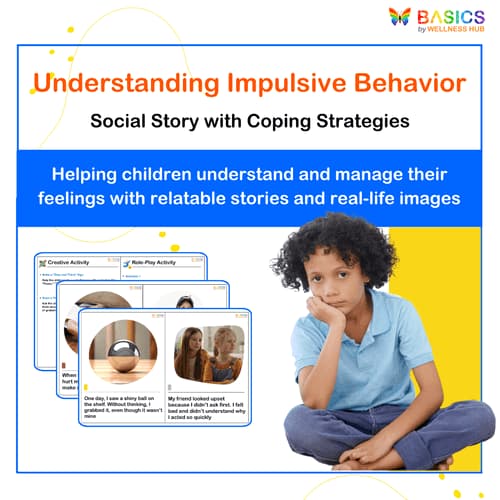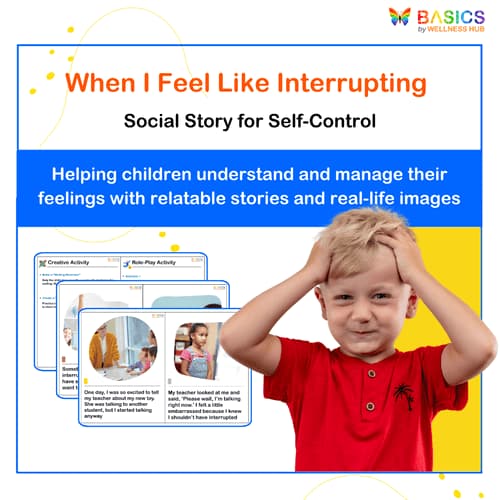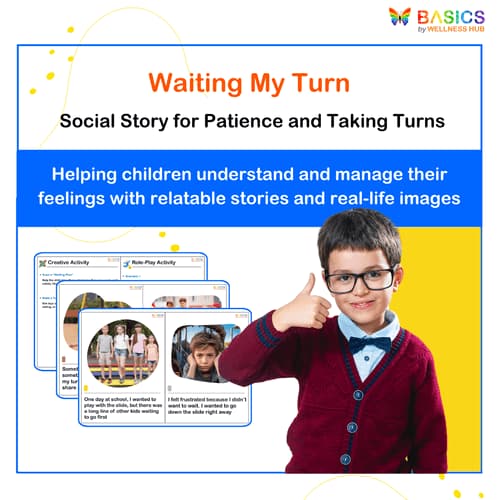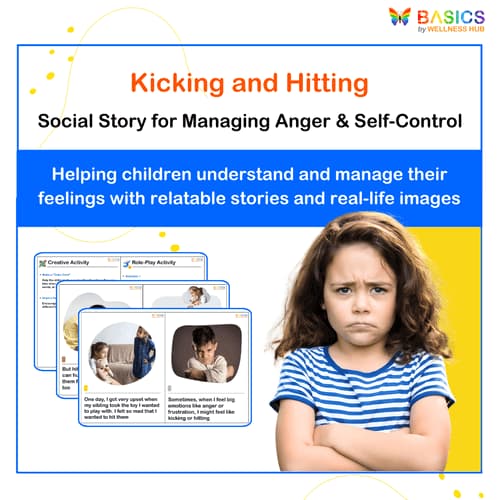





Learning to Be a Good Listener: Social Story for Kids
₹80
₹160
50% off
0 (0 ratings)
Grade Levels
Pre-K - Grade 2 (Ages 3-7)
Content Overview
Format: 1 PDF with 8 pages Features: Real-life images, first-person narration, and practical listening tips.
Categories
Pages from the Resource
This engaging social story teaches young children how to be good listeners using relatable, real-life scenarios. With first-person narration and realistic images, it helps kids understand the importance of listening attentively and following directions. A valuable resource for parents, educators, and therapists.

Page 1

Page 2
What Users Say
0
0 ratings
5
0+
4
0+
3
0+
2
0+
1
0+
5 Stars
Product is Good to use.
10 months ago
Varsha Parent
Similar Products

Understanding Impulsive Behavior: Social Story with Coping Strategies
₹ 80.00
₹ 160.00
50% off
4.9 (42 ratings)

When I Feel Like Interrupting – Social Story for Self-Control
₹ 80.00
₹ 160.00
50% off
4.8 (60 ratings)

Waiting My Turn – Social Story for Patience and Taking Turns
₹ 80.00
₹ 160.00
50% off
4.7 (56 ratings)

Kicking and Hitting – Social Story for Managing Anger & Self-Control
₹ 80.00
₹ 160.00
50% off
4.6 (52 ratings)

Understanding Swear Words – Social Story for Respectful Communication
₹ 80.00
₹ 160.00
50% off
4.9 (48 ratings)
About the Product
Purpose of Flashcards: Learning to Be a Good Listener is a social story designed to help children understand and develop the essential skill of active listening. The story is presented in the first person, allowing kids to easily relate to the scenarios and emotions described. This resource uses high-quality real-life images that closely align with the narrative, ensuring that children can visually connect with the situations. The story follows a continuous flow, creating a narrative rather than a series of disjointed statements. It is ideal for teaching young learners, especially those with developmental delays or special needs, how to focus on others when they are speaking and respond appropriately.
Product Details
Format: 1 PDF file
Total Number of Pages: 8
Content Overview: This social story is available as a PDF file with a total of 8 pages. Each page contains two statements, accompanied by high-quality real images that visually depict the scenarios. The images are carefully chosen to match the storyline while maintaining visual continuity, even if different children are featured across the pages. The real-life imagery helps children relate better to the content, making the lesson more impactful. The story format ensures a smooth and logical progression, guiding children through the process of learning how to be a good listener.
Features: High-quality, relatable images; continuous narrative flow
Educational Benefits
Improved Listening Skills: The resource helps children recognize the importance of listening when others are speaking, leading to better communication and stronger relationships.
Social and Emotional Learning (SEL): Through relatable scenarios, children learn how listening can help them understand others’ feelings, thoughts, and needs.
Behavioral Development: This social story reinforces positive behavior, teaching children how to be patient, attentive, and responsive in conversations.
Visual Learning: The inclusion of real-life images helps visual learners grasp the content more effectively, aiding retention and application in real-world situations.
Enhanced Language and Communication: By engaging with this social story, children practice essential communication skills, including asking questions and responding appropriately.
Instructions for Use
Reading the Story: Start by reading the story aloud to the child. Use an engaging and clear tone to draw attention to the different situations and how the character in the story responds as a good listener.
Discussing the Scenarios: After reading each page, discuss the scenarios with the child. Ask questions like, "How would you feel in this situation?" or "What can you do to be a good listener here?"
Real-Life Application: Encourage the child to practice the lessons from the story in everyday situations. Remind them of the story when they need to focus on listening, whether at home, school, or in social settings.
Repetition and Reinforcement: Revisit the story regularly. Consistent exposure to the lessons will help reinforce the importance of listening. You can even use the images and statements as prompts in everyday conversations to remind the child about being a good listener.
Role-Playing: To further reinforce the skill, engage in role-playing activities where the child can practice being an attentive listener in various scenarios, similar to those described in the story.
Activities Using the Resource
Role-Playing Listening Scenarios: This activity reinforces lessons from the story by practicing listening skills in various scenarios. Set up simple role-playing situations where the child alternates between being the listener and the speaker. Use prompts inspired by the story, such as discussing a favorite toy or talking about a recent event, and emphasize key listening behaviors like making eye contact, nodding, and responding appropriately. This helps the child internalize the behaviors associated with good listening, making it easier to apply these skills in real-life situations.
Discussion and Reflection: This activity deepens the child’s understanding of the concepts presented in the story. After reading, engage the child in a discussion about their takeaways by asking questions like, "Why is it important to listen when someone is speaking?" or "Can you think of a time when you were a good listener?" Encourage the child to reflect on their experiences and consider ways to improve their listening skills. This promotes critical thinking and self-awareness, helping the child appreciate and value the skill of listening.
Listening Journals: This activity provides a creative outlet for the child to express their thoughts and reinforces the lesson of listening. Encourage the child to keep a listening journal where they can draw or write about times they were a good listener. They might illustrate situations from the story or real-life experiences where they practiced effective listening. Reviewing the journal together periodically allows for discussion of their progress. This activity reinforces the concepts through creative expression and serves as a visual reminder of the child’s growth in listening skills.
Listening and Responding Games: This activity makes practicing listening skills fun and engaging. Play games like "Simon Says" or "Telephone," where the child must listen carefully to instructions or messages and respond accordingly. These games emphasize the importance of paying attention to details and responding appropriately, helping the child develop better focus and concentration—essential components of good listening skills.
FAQs
Q1: How can I ensure that my child fully understands the lessons from the story?
A1: Repetition is key. Read the story multiple times and engage your child in discussions after each reading. Use the role-playing activities to practice the skills in different scenarios.
Q2: Is this resource suitable for non-verbal children?
A2: Yes, the visual nature of the story and the use of real-life images make it accessible for non-verbal children as well. You can adapt the activities by focusing on gestures and non-verbal cues to enhance their understanding.
Q3: How often should we use this resource?
A3: It’s recommended to read the story and engage in related activities at least once a week. Regular use will help reinforce the concepts and make the lessons stick.
Q4: Can this resource be used in a classroom setting?
A4: Absolutely. This social story is an excellent tool for group discussions and role-playing activities in a classroom setting. It can be used to teach listening skills to an entire class or in smaller groups.
Q5: How do I handle a situation where my child struggles with listening?
A5: If your child struggles, be patient and consistent. Use the story to gently remind them of the importance of listening and practice the activities regularly. Celebrate small successes to build their confidence.
Usage Rights and Restrictions
Personal Use: This resource is intended for personal use by the purchaser and can be used in homes or classrooms. You may print copies for your own use or for the child’s use at home or school.
Sharing: The resource should not be shared electronically or physically with others who have not purchased it. Each family or educator should purchase their own copy.
Commercial Use: The resource is strictly for non-commercial use. It cannot be sold, distributed, or used for commercial purposes without prior written permission.
Mdification: You may not alter, modify, or create derivative works based on this resource without explicit permission from the creator.
Conclusion
Learning to Be a Good Listener is a valuable tool for helping children develop essential communication skills. By engaging with this social story, children can learn the importance of listening and how to apply it in everyday situations. With its carefully designed content, relatable images, and interactive activities, this resource is a must-have for parents, educators, and therapists aiming to foster better listening skills in young learners. We hope this resource becomes a cherished part of your child’s learning journey, helping them grow into thoughtful and attentive communicators.



